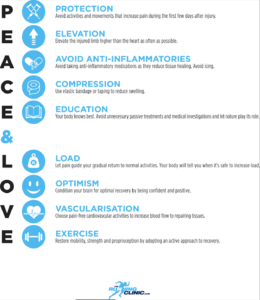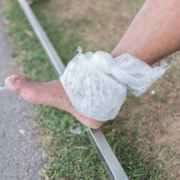A hot (or rather cold) topic that is often posed within the Sapphire Clinic walls is when and how much to ice after an acute injury. This is a reasonable question as the protocols & principles have morphed quite drastically over the years.
RICE
In 1978 Dr. Gabe Mirkin created the first acute injury response acronym of REST, ICE, COMPRESSION, ELEVATION. This concept included ice a key stakeholder in the reduction of the inflammatory cascade to elicit an accelerated recovery.
PRICE
Nearly a two decades later, the “P” was added to represent PROTECT by Kerr, Daley and Booth via ACPSM standards. Yet, this didn’t seem to quite cover it as there was no progressive re-introduction to building sport tolerance and REST discouraged movement.(3)
POLICE
In order to addressed these limitations, the “OL” was added, which represented OPTIMAL LOADING. Current research continues to support the notion that OL “…aids in recovery through cell generation induced by light mechanical loading in the early stages.(4)” Translation: relative rest through light movement is key in telling our brain we still need that body part and need it quickly.
Example: Pumping (stepping on an imaginary pedal) the ankle after sprain. This contraction creates a light muscle pump that naturally flushes excess inflammation from the body.
During this same time period, further contradictory evidence was emerging suggesting that the inflammatory cascade of an injury could be BENEFICIAL in recovery; Further, it indicated that the application of ice could hinder this response despite its ability to inhibit pain. In response, Dr. Mirkin officially retracted RICE in 2014 to draw attention to this new opposing evidence. (3,4)
Inflammatory cascade:
Say you roll your ankle, your body sends out macrophages which are inflammatory cells that deliver Growth Factor hormones to the injured area which kick starts the healing process by flushing out the damaged tissue. Where ice can impact this process is by blocking the body’s natural release of this hormone, thus delaying healing and increasing recovery time. (4)
PEACE & LOVE
Just when you thought the acronym couldn’t get any longer, PEACE & LOVE emerges in 2019 to address the limitations of POLICE. PEACE is designed to address subacute injury while LOVE is targeted toward the subsequent stages of tissue healing.
Science has proven that the inflammatory process can be beneficial but this is not applicable to all situations because science has also shown that long term inflammation can be equally detrimental. Chronic inflammation is often the cause of increased pain, muscular inhibition, reduced range of motion, etc.
With that being said, ice is an option to reduce pain and limit inflammation of minor acute injuries but should likely not be used to fully eliminate our natural healing process. On the other end of the spectrum, as in the case of a severe inflammatory event, one would want to interfere with the cascade to limit the detrimental effects of edema that can impact an individual’s recovery (i.e. post-op).
Conclusion
It is not a simple yes or no answer and like all good things in life, “it depends”. I hope this helps guide your thought process should you need to treat an acute injury in the future. If you are unsure how to respond appropriately, please seek out professional medical attention.
References:
- Glasgow P, Phillips N, Bleakley C. Optimal loading: key variables and mechanisms. British journal of sports medicine. 2015; 49(5):278-279.
- Journal of American Academy of Orthopedic Surgeons, Vol 7, No 5, 1999
- Mirkin, G. & Hoffman, M. (1978). The sportsmedicine book. (1st ed.). Little Brown and Co.
- Bleakley, C. M., Glasgow, P. & MacAuley, D. C. (2012). PRICE needs updating, should we call the POLICE? British Journal of Sports Medicine. 46, 220–221.
- Mirkin, G. (2014, March 16). Why Ice Delays Recovery. https://www.drmirkin.com/fitness/why-ice-delays-recovery.html
- Dubois, B. & Esculier, J-F. (2020). Soft-tissue injuries simply need PEACE and LOVE. British Journal of Sports Medicine. 54, 72-73.
- Vuurberg G ,Hoorntje A ,Wink LM , et al. Diagnosis, treatment and prevention of ankle sprains: update of an evidence-based clinical guideline.Br J Sports Med2018;52:956.doi:10.1136/bjsports-2017-098106
- Singh DP , Barani Lonbani Z , Woodruff MA , et al. Effects of topical icing on inflammation, angiogenesis, revascularization, and myofiber regeneration in skeletal muscle following contusion injury.Front Physiol2017;8:93.doi:10.3389/fphys.2017.00093





